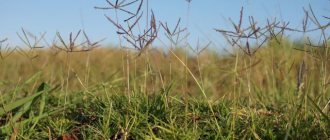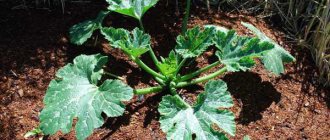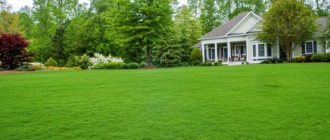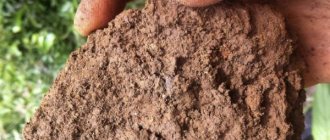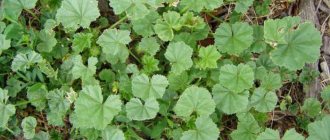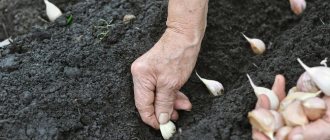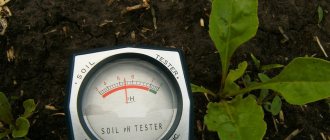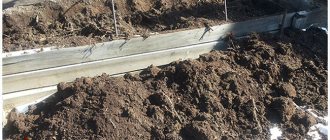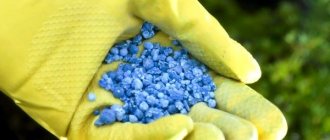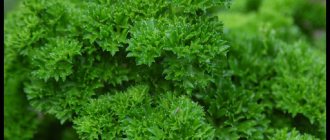Operating principle of covering material
The material covering the beds and flower plantings does not allow sunlight to pass through, which is necessary for weeds to survive. Weeds cannot break through to the light, biochemical reactions in their tissues are disrupted, and the root system dries out. Plants are dying.
To ensure that only the weeds are harmed and the cultivated species remain unharmed, the fabric is carefully placed on the beds, secured, and holes are cut in places corresponding to the location of the cultivated plants.
Modern types of ground covering not only reliably protect against the growth of weeds, but also do not provoke root rotting or the development of fungal diseases. They can not only cover beds and flower beds, but also cover paths in the garden to prevent weeds from getting through between the slabs. More dense material is placed between the beds to maintain a neat condition of the site.
Dense coating allows you to get rid of soil pests. Insects have difficulty orienting themselves in space and are unable to reproduce.
Advantages and disadvantages
The main advantage of using covering material is that it makes it easier to care for vegetable, berry, and flower crops. Ground covering is popular because:
- protects the top soil layer from unfavorable environmental conditions, prevents plants from withering from lack of moisture and nutrients, excess sunlight, heavy rainfall;
- creates microclimatic conditions that are ideal for the development of cultivated vegetation, but unfavorable for the proliferation of bacterial infections;
- simplifies the activities for caring for cultivated plants;
- suitable for use both in open areas and in greenhouses;
- Thanks to its dense structure, it has a long service life (up to 8-12 seasons), and does not lose quality and appearance during operation.
The disadvantages of covering fabric are due to its improper use:
- If the weed cover is installed or used incorrectly, a greenhouse effect occurs underneath it. And excess humidity, in the absence of air circulation, provokes the development of a fungal infection.
- The dark-colored canvas gets very hot under the sun, and the UV-stabilizing layer becomes ineffective after 2 months of use. Therefore, in the climatic conditions of the southern regions, hay, sawdust, and newsprint are used to protect plantings.
See also
Composition of Alistair Granda and instructions for use of the herbicide, application ratesRead
Advice from experienced gardeners
If you need a covering product to act as a mulch layer, then it is better to give preference to black or black-and-white non-woven fabric with a density of 42 or 60 g/m; black or black-and-white film is also suitable. For bedding in greenhouses, it is recommended to use black and white agrofibre. When using film covering material, the beds will need to be equipped with a drip irrigation system. If you need a capital solution, then you should choose geotextiles.
To temporarily protect plantings from ultraviolet radiation and low temperatures, it is effective to use white spunbond with a density of 17-30 g/m or film material. Such covering material is especially relevant at the beginning of the season, when delicate seedlings need reliable protection from precipitation and moisture evaporation.
There is no better material for arranging greenhouses than reinforced canvas; polyethylene is short-lived and has a low degree of resistance to mechanical damage. In addition, it has a shelf life of several seasons. In the absence of a heating system in greenhouse complexes, it is more advisable to use double-sided fabric, where one side is black and the other is foil. To enhance the effect, a white sheet with strips of foil is laid on top of the greenhouse for better transmission of sunlight. A bed under covering material makes it possible to get not only an early, but also a rich harvest.
Types of non-woven weed covering materials
Agro-fabric against weeds is sold on the market in a wide range of quality and price categories. You can choose a product according to color, density, structure and other preferences and needs.
Spunbond
The brand became so popular that summer residents began to use this word to call any covering material for their beds. Spunbond is a special fabric production technology. It turns out light, airy, but secure. The material is environmentally friendly and is not affected by temperature fluctuations or mechanical stress.
The color of spunbond is white and black, the density is 20-60 g/m2:
- White material up to 30 g/m2 is used primarily to protect crops from returning spring colds and abundant sunlight in summer. They cover seedlings, berry gardens, ornamental species, and flower beds. And spunbond protects young fruit tree seedlings from harmful insects.
- White canvas 30-50 g/m2, suitable for winter protection of any ornamental and fruit crops. It is also stretched over an arc frame greenhouse or greenhouse.
- Black spunbond 50-60 g/m2 with a UV-stabilizing layer reliably protects against weeds and helps crop plants receive more heat.
Geotextiles
Geofabric, which is based on polyester fibers woven under thermal influence, is characterized by strength and ability to pass air. The popularity of the product is due to:
- long service life;
- versatility of application;
- ease of installation on site;
- low cost.
Agrospan
In fact, a type of spunbond produced by the Russian company. Same quality, durable, inexpensive. It is used primarily for covering strawberries, strawberries and other berries.
Agrofabric has a UV-stabilizing layer, wears out slowly, and is not susceptible to temperature fluctuations.
Therefore, it is used as a winter shelter, but also works well as a weed control.
Agrotex
Another popular type of covering material from a Russian manufacturer. Available in two colors:
- yellow - intended to destroy pests on nightshade plants;
- black - a weed control agent, used mainly on strawberry plantations.
The material has a perforated structure, so there is no need to cut holes for cultivated plants. It is enough to cover the area in the garden, and the cultivated plantings will not suffer from high temperatures or get dirty with soil during watering and precipitation. Agrotex does not wrinkle, is not afraid of temperature fluctuations, and does not provoke soil damage by bacterial infection.
Agril
Breathable fabric designed specifically for weed control. Covered plants do not wither from the heat and do not freeze during the cold period. The covered soil remains loose, is not subject to crust-forming and erosion processes, its biochemical component is not disturbed, oxygen and nutrition continue to be fully absorbed by the roots. With proper use of the material, cultivated plants produce crops earlier. You can use agril to mulch strawberries and vegetable beds.
See also
How to fight a weed called American, the best methods and preventive measuresRead
To control weeds, black material with a density of 50 g/m2 is used. For greenhouse equipment, use transparent fabric with a density of 20-40 g/m2.
Lumitex
It is a corrugated film coating with a soft structure and different colors. Due to its ability to reflect harmful sun rays and transmit beneficial ones for plants, even in cloudy weather, agrofibre is used to cover cucumber and berry beds, does not provoke overheating and hypothermia of plants, and accelerates the ripening of fruits.
When equipping a greenhouse, you can combine Lumitex with polyethylene film.
Lutrasil
Typically used for cold protection, but can be a good weed killer. The material is of high quality, costs a little more than spunbond, but is actually similar in quality. Available in two color variations - white and black. Density – from 20 to 60 g/m2.
Coating is applied:
- white low density - to protect seedlings and seedlings from spring frosts;
- high-density white - as a winter shelter (in frosts up to 8-10 °C);
- black medium and high density - against weeds.
Black film
Before the advent of agrotextiles, black film was the only material for covering the soil from weeds. It darkens perfectly. It can be used to cover not only beds, but row spacing.
Today, film is significantly inferior to modern agricultural fabrics:
- does not allow water to pass through;
- creates a greenhouse effect, which increases the likelihood of fungal infection;
- has a short service life.
Material for crushed stone against grass growth
Video: What material to lay under crushed stone to prevent grass from growing
A garden path made of crushed stone and gravel may well become a unique element of garden decor. By following the installation technology, you can reduce the germination of weeds and grass on them to a minimum.
Film
Conventional types of vinyl films that are used in everyday life are not suitable for laying paths due to their thinness. For grass to grow, it needs light. Therefore, it is better to lay a black permeable film under the crushed stone:
- agril is a polypropylene non-woven fiber characterized by high light and water permeability;
- lutrasil is a lightweight, elastic synthetic material made from polypropylene threads connected by needle-punching, chemical reactions and welding, permeable to water and moisture.
Lutrasil
Note! These materials are also used as covering materials in agricultural technology. They have different densities.
When using regular thick household film, you need to make holes in it so that moisture goes into the ground.
Geotextiles
Belongs to a class of building materials intended for creating layers for various purposes. Divided into:
- woven fabric (geo-fabric), which is made from glass or polyester fibers;
- non-woven fabric made from polypropylene and polyester threads.
Non-woven geotextiles are divided into needle-punched and thermally bonded, depending on the method of joining the fibers.
Geotextiles
Properties and characteristics:
- elasticity;
- resistance to mechanical loads;
- protects the soil from movement;
- environmentally friendly.
Other materials and fabrics
To prevent grass from growing, you cannot cover the ground with anything. The substrate for crushed stone, used to create a decorative path or backfill, must allow moisture and air to pass through. Otherwise, the water on the surface will stagnate with all the ensuing consequences. Such a coating will be especially unsuitable as an entrance to a house or cottage.
How are covering materials used?
Below are step-by-step instructions for using a weed cover. Need to:
- Use any method to clear the area of weeds.
- Add fertilizer. Level the ground.
- Cut a piece of fabric according to the size of the area with an allowance for fastening of 15 cm.
- Cut holes in the form of crosses or circles for cultivated plants.
- In calm weather, cover the area with material.
- Secure the allowances with stones in the dug grooves or cover them with earth.
- At different points of the site, attach the material to the soil with wire pins 10 cm long.
- Sow seeds into the holes and plant seedlings.
How to water covered plants?
Modern covering material allows water to pass through freely.
Watering is carried out using the irrigation method; there is no need to remove the canvas. Liquid fertilizer is carefully poured into the hole.
To prevent waterlogging of the soil and rotting of plants, the moisture level is checked through a cut hole.
The popularity of agrotextiles among farmers and summer residents is not surprising. Easy to use, breathable, durable, resistant to adverse factors, the material allows you to forget about the existence of weeds for the entire season. At the same time it is inexpensive.
Mulching
This option is chosen by those who do not want to constantly weed. This method reduces the need for weeding, provides protection from slugs, and allows you to avoid walking directly through the mud in the garden after heavy rain. In addition, soil moisture is better maintained. Such a garden will look more well-groomed and modern.
A variety of materials are chosen as mulch. It all depends on the desires and capabilities of the summer resident. For example, you can use regular grass clippings, peat or straw. Sometimes gravel and sand are used for these purposes. Geotextiles are laid under the mulch layer, which helps preserve it.
